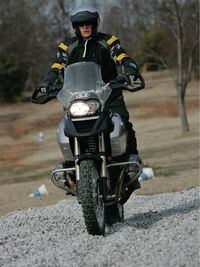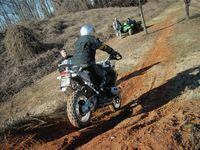As I stand on the pegs, the big boxer thumping beneath me, all the lessons of the last two days click into place. Riding in second gear, two fingers feathering the clutch, I coax the big Beemer around on a trail that looks like it was built for mountain bikes. A massive gravel mound looms before me, so I give the bike a shot of gas as the suspension compresses and we launch up the impossibly steep bank. Applying the brakes, I stop the bike on a narrow ledge before sliding my right knee towards the cylinder head, butt off the seat, and turning the big GS 90 degrees. With some light pressure on the front brake and my foot hovering over the rear, I execute a slow, measured descent under the watchful eye of Ross McKinney, our lead instructor for the day.
Arriving at the BMW Performance Center in Spartanburg, SC., the previous morning, I had fielded a question from one of my classmates: “Why is a motorcycle journalist taking a riding school?” The answer is simple: I might ride motorcycles for a living, but my skill level is little past average, so I’ve made sure to get excellent training over the years. This school provided a chance to put another tool in my bag of skills for the times I take an adventure bike off-road.
With a high teacher-to-student ratio and a curriculum that consists mostly of riding time, the BMW Off-Road Riding School (there’s an on-road option too) has us quickly in the saddle for the first lesson. I’m riding an R1200GS, but you can also choose between an F800GS or an F650GS. Within a specially laid-out course at the BMW car-training facility, we will spend two days working to improve our riding skills while unlocking the secret to enjoying heavy off-road touring machines.
First, we work on balance. Standing on one side of the bike, then the other, then sitting with our legs over the seat, is immediately challenging. You have to use every bit of concentration to follow and execute the drill, which is thoroughly explained, demonstrated by a BMW instructor and then practiced under their watchful eye. At any time during a particular drill, our instructors might pull us aside to break down techniques in further detail. Each instructor is trained by BMW, so not only can they perform each lesson with excellent form, but they are astute at noticing which areas students need improvement in.
Under the leadership of Bill Conger, a man whose accomplishments on two and four wheels could fill many paragraphs, our instructors soon have us riding over mud hills and through impossibly narrow gaps between tree trunks, all under full control. Bill tells me to work the clutch with just the first two fingers so as to minimize actions and save my clutch hand from fatigue. He knows how awkward it feels, and reassures me that by the time I leave, I’ll still be able to pick up a cup of coffee with my left hand and be comfortable with this new technique. He’s not wrong.
As we worked our way up to bigger obstacles and sand traps that look like they would swallow us up, it was another student, Todd Narduzzi, who summed up my thoughts best: “What I like about this program is how they break the drills down to individual steps, enable you to practice each step, and then reconstruct them into one fluid drill. I realized that I’ve been riding on autopilot. This school is forcing me to think about my riding and to feel the difference when I get it right.”
Hoping he doesn’t quit his day job and start doing mine, I move from one area of the Performance Center to the next, feeling the building nature of the drills and noticing my higher level of control. The first day had begun with heightened feelings of trepidation, but mid-way through the second day that was gone, leaving me hungry for the next adventure.
Another student, 52-year-old Curt Johnson, has a dream to ride the Trans-America Trail. Not long after buying his BMW R1200GS, he signed up for the school, and tells me; “It was fantastic. We were methodically introduced to basic off-road skills and then more advanced techniques that continued to build on each other, and after two days we were able to participate in very advanced riding drills.”
During the emergency stopping drill, it was eye-opening to see how poorly a motorcycle stops in the dirt with the ABS engaged. Conversely, we were also shown how quickly the bike can stop with the rear wheel locked and the front on the edge of traction. To prepare, we first learned to lock up the rear brake, leaving it locked as we came to a halt. More nerve-wracking, however, was learning to lock the front wheel and letting it plow momentarily through the dirt before releasing the brake lever. It’s a completely alien feeling to have the front end pushing, so I found it interesting, when performing emergency stops later, how much more confidence I had in the front brake.
__We ended the school tired but happy. My riding skill set had just taken a huge step forward, and my classmates were all on the same page. Where we are going or what we are riding is irrelevant; we are better, safer motorcycle riders, on-or off-road, for attending the BMW riding school.
The off-road training program is offered in a one-day version for $595 or as a two-day class for $1095; the price includes the use of the motorcycle.
Contact:
_www.bmwusa.com_

















/cloudfront-us-east-1.images.arcpublishing.com/octane/HXOUJXQWA5HBHGRO3EMJIGFMVI.jpg)

/cloudfront-us-east-1.images.arcpublishing.com/octane/3TIWWRV4JBBOLDVGRYECVVTA7Y.jpg)
/cloudfront-us-east-1.images.arcpublishing.com/octane/KIX5O23D5NAIBGFXBN3327DKZU.jpg)
/cloudfront-us-east-1.images.arcpublishing.com/octane/7GJYDUIPXRGMTMQKN6ONYOLBOU.jpg)
/cloudfront-us-east-1.images.arcpublishing.com/octane/MUQLOVLL2ZDGFH25ILABNBXKTI.jpg)
/cloudfront-us-east-1.images.arcpublishing.com/octane/TNOU5DNE2BC57MFPMGN2EIDXAM.jpg)
/cloudfront-us-east-1.images.arcpublishing.com/octane/GTCXACQGJ5HAPDTGWUQKDEH44E.jpg)
/cloudfront-us-east-1.images.arcpublishing.com/octane/S35YGSEMEZB4BLTDJTSZPF4GLA.jpg)
/cloudfront-us-east-1.images.arcpublishing.com/octane/5UOT6HPX2JFMRJAX6EH45AR4MQ.jpg)
/cloudfront-us-east-1.images.arcpublishing.com/octane/OKWOJWAKP5EP3OACCRRWPCIX2Q.jpg)
/cloudfront-us-east-1.images.arcpublishing.com/octane/2WF3SCE3NFBQXLDNJM7KMXA45E.jpg)
/cloudfront-us-east-1.images.arcpublishing.com/octane/G4MG6OUCJNBSHIS2MVVOTPX65E.jpg)
/cloudfront-us-east-1.images.arcpublishing.com/octane/IIGGWFOTOJGB7DB6DGBXCCMTDY.jpg)
/cloudfront-us-east-1.images.arcpublishing.com/octane/QSTCM6AVEZA5JJBUXNIQ3DSOF4.jpg)
/cloudfront-us-east-1.images.arcpublishing.com/octane/U4I7G625B5DMLF2DVIJDFZVV6M.jpg)
/cloudfront-us-east-1.images.arcpublishing.com/octane/B6XD6LS6IVCQPIU6HXDJSM3FHY.jpg)
/cloudfront-us-east-1.images.arcpublishing.com/octane/ICL63FEDDRDTTMINYICCEYGMDA.jpg)
/cloudfront-us-east-1.images.arcpublishing.com/octane/FCGZHQXRBZFLBAPC5SDIQLVF4I.jpg)
/cloudfront-us-east-1.images.arcpublishing.com/octane/WNOB6LDOIFFHJKPSVIWDYUGOPM.jpg)

/cloudfront-us-east-1.images.arcpublishing.com/octane/X33NU3E525ECRHXLNUJN2FTRKI.jpg)
/cloudfront-us-east-1.images.arcpublishing.com/octane/6KKT5NNL2JAVBOXMZYS5ZO76YA.jpg)
/cloudfront-us-east-1.images.arcpublishing.com/octane/J5RKG5O455GMPGQRF2OG6LRT7A.jpg)